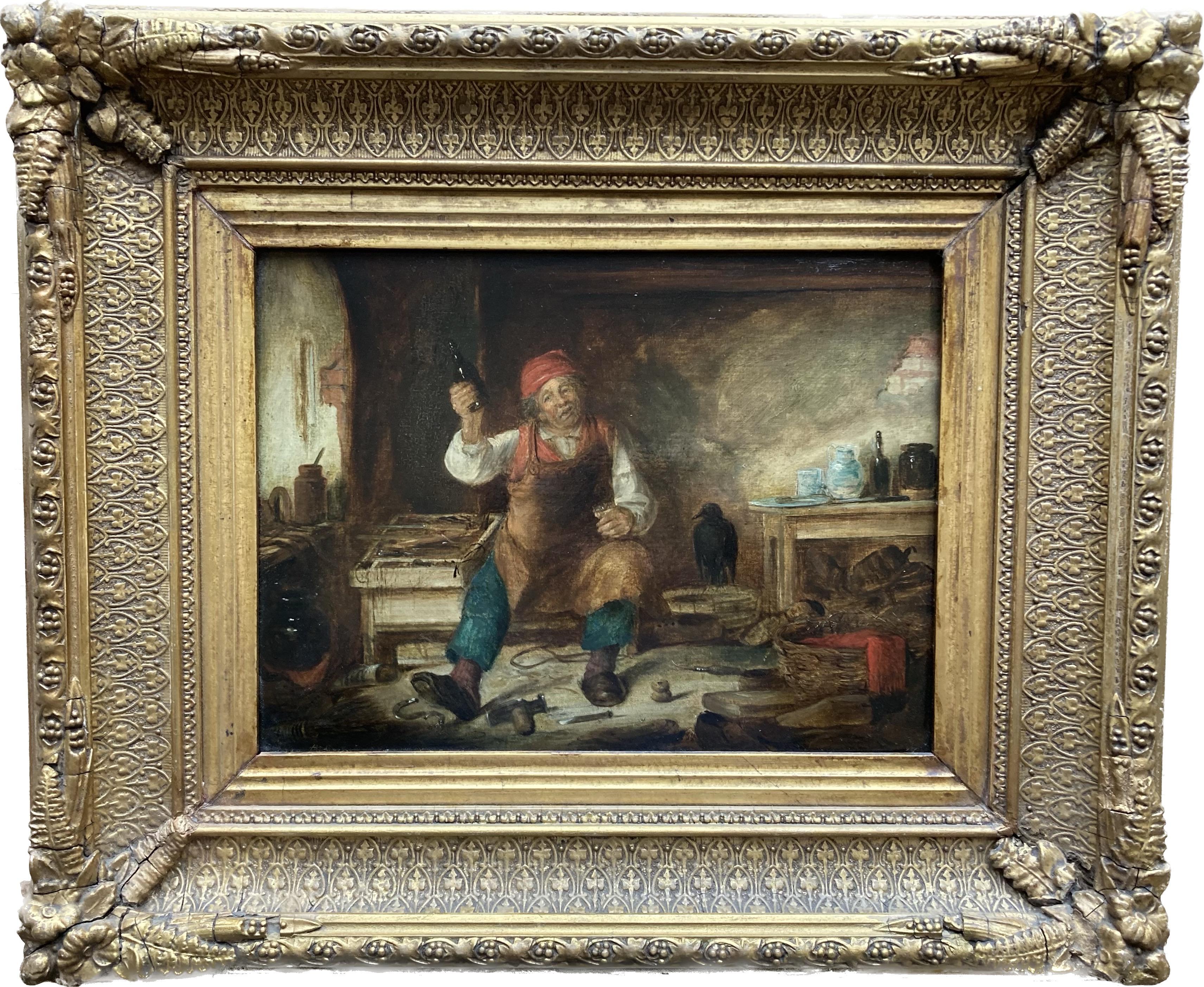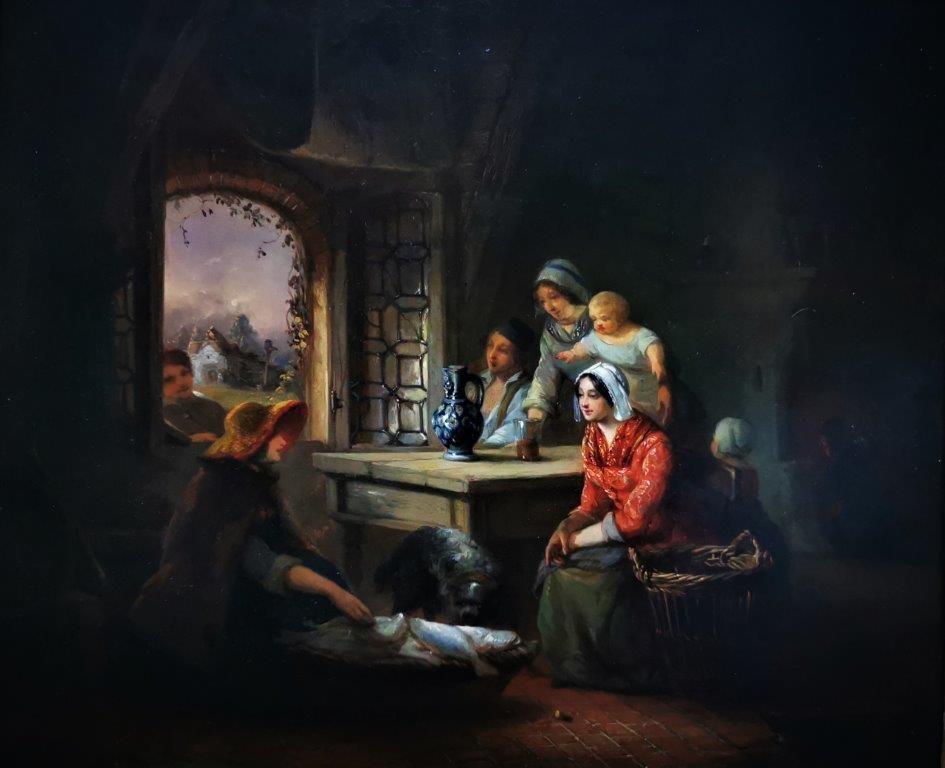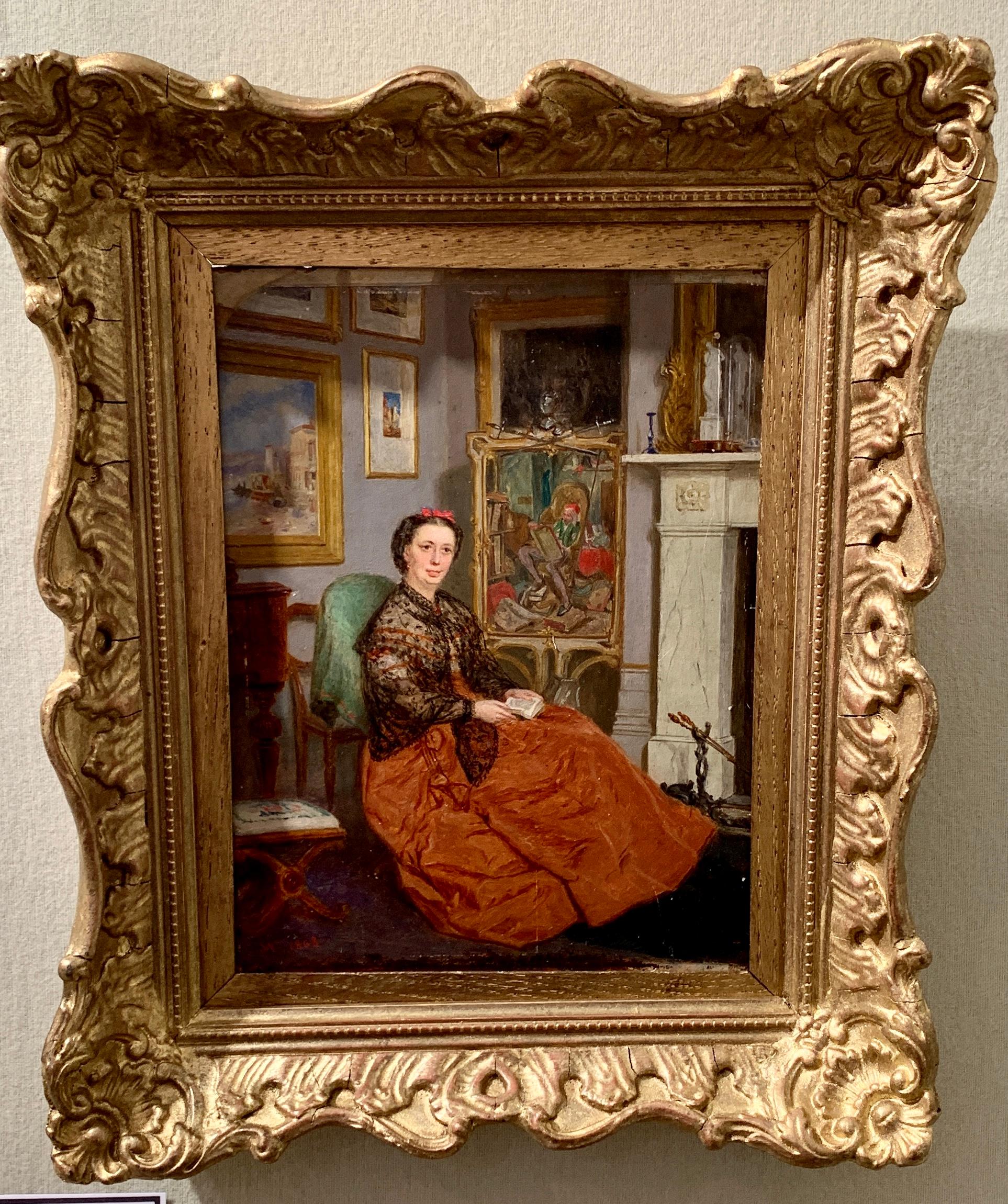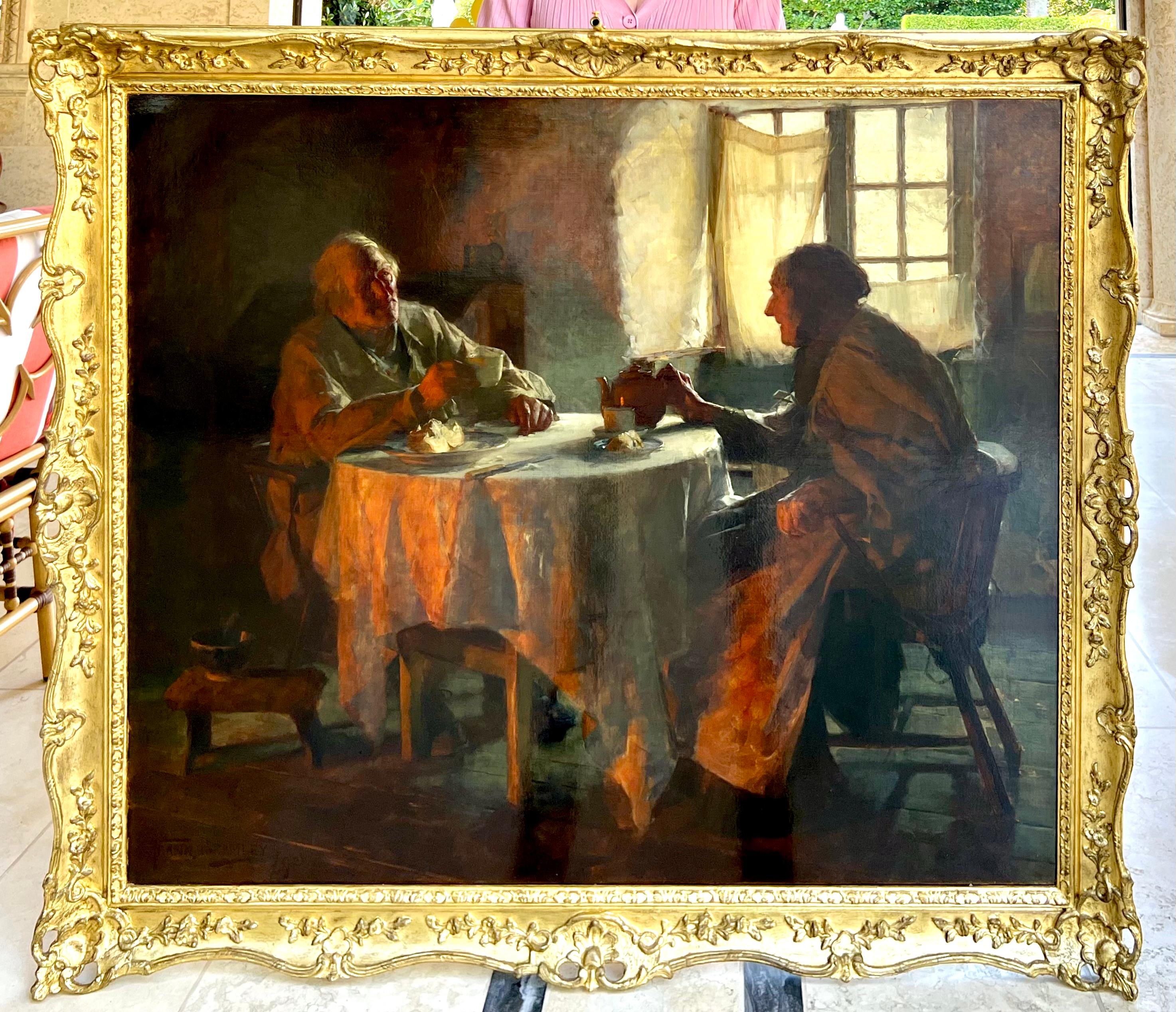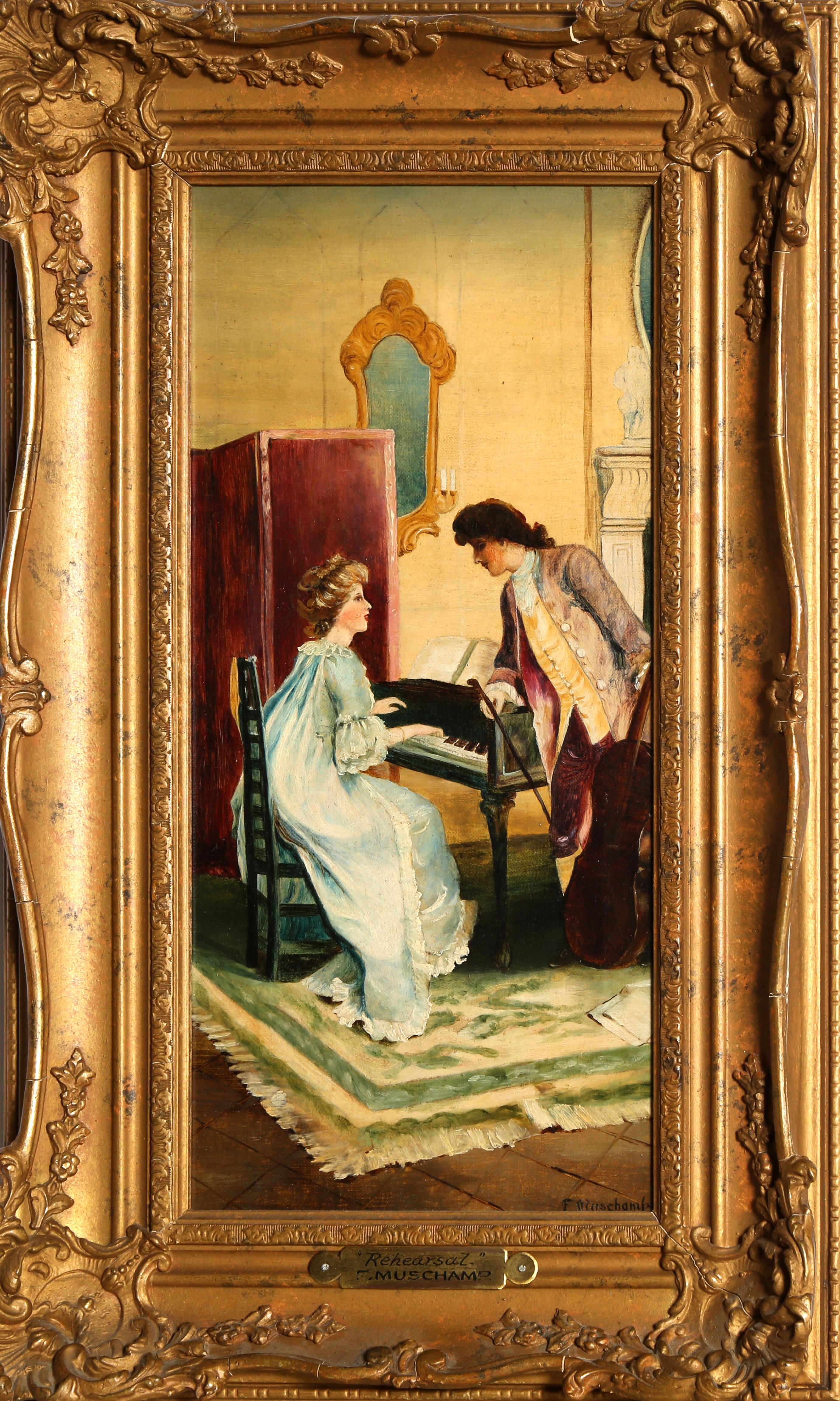Items Similar to Scottish Interior - Scottish 19th century Victorian art interior oil painting
Want more images or videos?
Request additional images or videos from the seller
1 of 14
George HayScottish Interior - Scottish 19th century Victorian art interior oil painting circa 1870
circa 1870
About the Item
A fine Scottish Victorian interior scene by George Hay RSA. A very vibrant stunning Scottish historical interior painting which dates to about 1870. It depicts two women curtsying before an aristocratic man who enters the room.
Signed right.
Provenance. Sotheby.
Aitken Dott - The Scottish Gallery label verso.
Condition. oil on canvas, image size is 24 inches by 18 inches. Good condition.
Housed in a stunning gilt gallery frame, 32 inches by 26 inches framed. Very good condition.
George Hay (1831-1912) was born in Leith, Edinburgh. He studied under Robert Scott Lauder (1803-1869) together with William Quiller Orchardson (1832-1910), William McTaggart (1835-1910) and Hugh Cameron (1835-1918). Hay specialised in narrative paintings, his subjects often inspired by Sir Walter Scott's Waverley Novels. He became an Associate Member of the Royal Scottish Academy (RSA) in 1869 and a full member in 1876, appointed Secretary of the Academy in 1881 and 1907. In 1878 he was a founder member of the Royal Scottish Society of Painters in Watercolours (RSW). He is recorded as living at several addresses in Edinburgh, including 3 Kings Place, from where he exhibited from 1856 to 1864, 16 Picardy Place (1865-1787), 12 Queen Street (1876-1882), 63 Queen Street (1883), 9 Castle Terrace (1884) and 7 Ravelston Terrace (1885-1926). He exhibited 132 works at The Royal Scottish Academy between 1856 and 1913 (and two further works were exhibited posthumously in 1926). His work "Caleb Balderstone's Ruse" is part of the Diploma Collection at the Royal Scottish Academy.
- Creator:George Hay (1831 - 1912, Scottish)
- Creation Year:circa 1870
- Dimensions:Height: 26 in (66.04 cm)Width: 32 in (81.28 cm)Depth: 2 in (5.08 cm)
- Medium:
- Movement & Style:
- Period:
- Condition:
- Gallery Location:London, GB
- Reference Number:1stDibs: LU853113202632
About the Seller
5.0
Platinum Seller
These expertly vetted sellers are 1stDibs' most experienced sellers and are rated highest by our customers.
1stDibs seller since 2018
401 sales on 1stDibs
Typical response time: <1 hour
- ShippingRetrieving quote...Ships From: London, United Kingdom
- Return PolicyA return for this item may be initiated within 14 days of delivery.
More From This SellerView All
- Children in School Room Interior - British Victorian Newlyn School oil paintingLocated in London, GBThis superb, large British Victorian oil painting is by noted Newlyn and Menton artist Arthur Alfred Burrington. It was painted circa 1890 when Burrington was most likely in Newlyn, ...Category
1890s Victorian Interior Paintings
MaterialsOil
- Violinist in an Interior - British Impressionist 19thC art musical oil paintingLocated in London, GBThis superb British Impressionist 19th century oil painting is by noted artist William Christian Symons. Painted circa 1880 it is a figurative interior composition of a musical event...Category
1880s Impressionist Figurative Paintings
MaterialsOil
- The Serving - British Old Master 18th century oil painting historical interiorBy (Circle of) William HogarthLocated in London, GBA superb British Old Master oil painting which is attributed to circle of William Hogarth and was painted circa 1760. This fine oil painting is in good clean condition and depicts a ...Category
18th Century Old Masters Figurative Paintings
MaterialsOil
- Interior with Lady Reading - Scottish Edwardian 1910 art portrait oil paintingLocated in London, GBThis superb Scottish Edwardian Impressionist interior oil painting is by noted Scottish female artist Annie Rose Laing. Painted circa 1910, the composition is the interior of a room...Category
1910s Impressionist Interior Paintings
MaterialsOil
- Christ Expelling Money Changers - British 30's surrealist art religious interiorBy Augustus LunnLocated in London, GBPainted by "Modern British" artist Augustus Lunn this oil/tempera on board depicts Christ Expelling the Money Changers. He exhibited widely at The Cooling Galleries and The New Engl...Category
20th Century Surrealist Figurative Paintings
MaterialsOil
- Cornish Family in an Interior - British 1912 Newlyn School art oil paintingBy Harold HarveyLocated in London, GBThis superb British figurative interior oil painting is by noted Newlyn school artist Harold Harvey. Painted circa 1912 the composition is a Cornish family, bathed in golden light, s...Category
1910s Realist Interior Paintings
MaterialsOil
You May Also Like
- Charming Victorian interior scene of a blacksmith enjoying a drinkLocated in Harkstead, GBA very characterful image of a farrier or blacksmith enjoying a drink in an interior. Alfred H Green (working 1844-1878) A farrier in an interior enjoying a drink Signed Oil on boar...Category
Mid-19th Century Victorian Interior Paintings
MaterialsOil, Board
- "Family Interior Scene”, peasant family in 19thC Austria, original oil on paperLocated in Nutfield, SurreyFrans Wens (19th Century). A charming family interior scene painted by the Austrian artist Frans Wens. There is little recorded biographical informat...Category
19th Century Victorian Interior Paintings
MaterialsPaper, Oil
- English 19th century Victorian Antique portrait of a seated lady in her InteriorLocated in Woodbury, CTEnglish 19th century Victorian Antique portrait of a seated lady in her Interior Victorian portrait interior. John Waston Chapman was a pa...Category
1860s Victorian Interior Paintings
MaterialsPanel, Oil
- Tea TimeBy Frank BramleyLocated in Wiscasett, MESigned and dated 92 lower left. Oil on canvas. Frank Bramley British, 1857-1915 Frank Bramley is considered one of the most important artists of the Newlyn School, the group of artists who settled in Newlyn, Cornwall during the 1880s and 1890s, drawn by the light, lifestyle and the example of Alexander Stanhope Forbes, and were at the forefront of 'British Impressionism'. He was particularly ‘in the news’ when his painting of a woman reading in a garden made the astonishing price of $590,000 at Sotheby's New York in late May 1996. As the seminal catalogue of the famous Newlyn School exhibition states, Bramley's reputation has rested for some time on Hopeless Dawn, his major RA exhibition of 1888, and which in recent years has been hung almost constantly at the Tate Gallery. Bramley was born in Lincolnshire and trained at Lincoln Art School, later at Verlat's Academy in Antwerp, from where he went to Venice in 1882-83, where our painting was executed. He first showed at the Royal Academy in London in 1884 (both paintings were Venetian scenes), and it was in the winter of 1884/5 that Bramley settled in Newlyn. He was a quiet and reserved figure, prone to bouts of melancholy. He worked on his own in a tiny studio in an old thatched cottage - the cottage consisted of two rooms, one at ground level (which was the studio) and one which was below ground which was inhabited by a woman who'd lost her arms and who managed to look after a set of tiny children as well as a small potato and turnip shop. Bramley moved to a purpose-built glass studio in 1889. He is known as the master of the so-called 'square-brush technique' which characterizes much of the best Newlyn School work and he used this until 1893, later than most of his colleagues. Bramley was friendly with the great artist Sargent and with him was elected an associate of the Royal Academy in 1894, being elected a full member in 1911. In 1891 he had married, and 4 years later they moved to the Midlands where his work became less socially orientated and more purely decorative. His last years were spent in a London flat...Category
1890s Victorian Figurative Paintings
MaterialsOil
- Antique English 19th century interior with mother and child and family treasuresBy Daniel PasmoreLocated in Woodbury, CTDaniel Pasmore the Younger was a London genre and portrait artist who exhibited mostly at the Society of British Artists in Suffolk Street, London. He i...Category
1850s Victorian Interior Paintings
MaterialsCanvas, Oil
- Rehearsal, Victorian Era painting by Francis Sydney MuschampBy Francis Sydney MuschampLocated in Long Island City, NYAn original oil on canvas painting measuring 17 x 8 inches by F.S. Muschamp, signed lower right. In the nineteenth century, the Neo-Classical movement bloomed, bringing forth a new style and interpretation of the past. F. Sydney Muschamp...Category
Late 19th Century Victorian Interior Paintings
MaterialsOil, Canvas
Recently Viewed
View AllMore Ways To Browse
Young Edwardian Vintage
Zamy Steynovitz Original Painting
Ae France
Alfred Wallace
Altar Catholic
Antique Indian Temple Doors
Castas Art
Catholic Altar
Celluloid Advertising
Dia De Los Muertos Figure
Doctor Doll
Jose Marquez
M F Hussain
Nancy Patterson
Olaosun Oluwapelumi
Red Skelton Art
Roaring 20s Painting
Rose Freymuth
